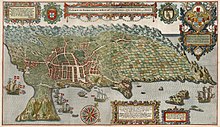Castelo dos Moinhos

Castelo dos Moinhos (German: Castle of the Mills ), also called Castelo de São Cristóvão , Forte de São Luís , Castelo de São Luís , is the name of a defensive system built in the 15th and 16th centuries of the city of Angra do, which has been a World Heritage Site since 1983 Heroísmo on the Azores island of Terceira . The name "Castle of the Mills" is derived from the mills that were built on the slopes of the castle hill.
Only chest-high defensive walls remain from the original castle. The stones of the original castle complex, which had fallen into ruins, were used between 1845 and 1856 for the construction of the Alto da Memória monument, which was intended to commemorate the fact that ex-King Pedro IV first set foot on Portuguese soil in Angra during the War of the Miguelists .
Today the facility is located in the eastern part of the municipality of Sé , the castle hill marks the transition to the municipality of Nossa Senhora da Conceição . The ruins and the Alto da Memoria monument can be accessed via the gardens of the Duke of Terceira or directly via Rua do Pisão.
history
Terceira, one of the islands in the central group of the Azores , was discovered by Portuguese sailors in the 15th century. Álvaro Martins Homem, one of these seafarers, founded the city of Angra on Terceira and built the predecessor of today's ruin between 1460 and 1470. The facility was of modest size and was further inland, but overlooked the valley, river and port of Angra. The design was typical of a late medieval castle complex. The earthworks during the construction resulted in an artificial gorge, which Álvaro Martins had already expanded in 1461 so that several mill wheels could be operated with the water dammed here. Writings from priests who worked on the island in the 16th and 17th centuries mention the existence of several mills, which led to the name "Castle of the Mills".
Álvaro Martins Hamem was awarded a captaincy by the Portuguese king in 1474 as a thank you for his services , but the captaincy of Praia. The captain of Angra was given to João Vaz Corte-Real . He was feudal lord and governor of Terceira. Corte-Real refrained from further expanding the defense system. It was only when Castilian sailors attacked the island that Infanta Beatrice, who was the captain's administration for her son and successor to the captaincy, Dom Diogo, commissioned Anes Rebelo with the expansion of a castle complex, which was completed around 1493 official name Castelo de São Luís received.
From 1495 the castle was the seat of the Alkalde (Alcaidaria-mor) of the city. This could explain why the castle was called Castelo de São Cristóvão towards the end of the 16th century, as a Cristóvão de Moura was the captain of the island when the office of the alkali fell to the captain.
In the 16th century the castle lost its function as a defensive structure for the city. The Italian fortress builder Thomas Benedetto began in 1567 to design defensive structures for the Azores Islands on behalf of the Portuguese kings, which were primarily aimed at protecting ports and anchorages. This concept was also followed by Benedetto's successor, Ciprião de Figueiredo e Vasconcelos. The old castle complex lost all strategic importance. In his História Insulana, Father António Cordeiro (1641–1722) described the castle only as a ruin, of which only the walls remained. In 1839 the land on which these ruins stood was transferred to the city of Angra with the order to build a promenade here. In 1844 work began on the erection of the monument to commemorate the visit of the Portuguese ex-King Pedro IV: to this island. When this monument was built, a large part of the remaining walls of the castle were used.
Single receipts
- ↑ Webpage of the Azores , accessed on October 6, 2016
- ↑ Primary sources on the sea voyages of the Corte Real family ( Memento from August 20, 2014 in the Internet Archive ) (English)
Coordinates: 38 ° 39 ′ 33.2 " N , 27 ° 13 ′ 10.4" W.

